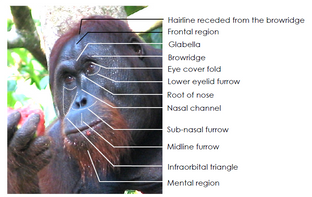OrangFACS
(A FACS system adapted for orangutans)
What OrangFACS is:
The Orangutan Facial Action Coding System (OrangFACS) is a scientific observational tool for identifying and coding facial movements in Orangutans. The system is based on the facial anatomy of orangutans and has been adapted from the original FACS system used for humans created by Ekman and Friesen (1978). The OrangFACS manual details how to use the system and code the facial movements of gibbon objectively. The manual and certification is freely available (see below).
More info regarding the development of this FACS system can be found here:
What OrangFACS isn't:
OrangFACS is not an ethogram of facial expressions, and does not make any inference about any underlying emotion or context causing the movement. Instead this is an objective coding scheme with no assumption about what represents a facial expression in this species. It will not explicitally teach you Orangutan facial expressions.
Accessing the manual
Accessing the Test
The OrangFACS Manual is freely available via the link below. For access to the manual, please contact us on animalfacsuk@gmail.com with the following information.
- Name
- Institution (if applicable)
- Reason for requesting OrangFACS
You will be then provided with a password to access the manual at the following link:
Please allow 7 working days for a response.
- PlInstitution
- Reason for
To become a certified OrangFACS coder, we encourage you to take the associated test. The OrangFACS test involves trainees to accurately code the facial movements in a series of video clips.
The password for test materials, and further instructions, can be provided upon request via email (animalfacsuk@gmail.com)
Access to OrangFACS test materials.
Please allow 7 working days for a response.
The people behind it
-
OrangFACS was developed thanks to the joint effort of:
- Cátia C. Caeiro, Department of Psychology, University of Lincoln
- Bridget M. Waller, Department of Psychology, Nottingham Trent University
- Elke Zimmermann, Institute of Zoology, University of Veterinary Medicine Hannover
- Anne M. Burrows, Department of Physical Therapy, Duquesne University (PA, USA)
- Marina Davila-Ross, Department of Psychology, University of Portsmouth
Acknowledgments
The authors would like to thank all the institutions and people that somehow contributed to make this project
- To the funding institutions/grants:
- European Commission Leonardo da Vinci grant,
- Center for Systems Neuroscience Hannover, Forschungszentrum Jülich,
- Gesellschaft der Freunde der TiHo,
- University of Veterinary Medicine Hannover;
- To the institutions where the data collection took place:
- Apenheul Primate Park (The Netherlands),
- Leipzig Zoological Garden (Germany),
- Sepilok Rehabilitation Centre (Malaysia),
- Tierpark Carl Hagenbeck (Germany),
- Zoo Wilhelma (Germany);
- To the people who assisted in collecting part of the audio-visual material:
- C. Schopf, E. Ey,
- M. Wessels,
- S. Johnson;
- To the people that sent additional photographs:
- C. Rodrigues,
- F. Lasmana,
- N. Baptista,
- R. Sharma;
- To collaborators that were involved on the reliability assessment:
- M. Lembeck,
- P. Kuchenbuch;
- To the institutions that established a mobility partnership acting as host/sending organizations:
- Faculty of Sciences of the University of Lisbon,
- University of Portsmouth.
